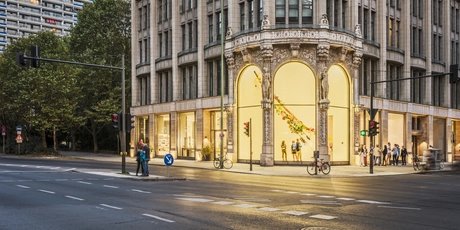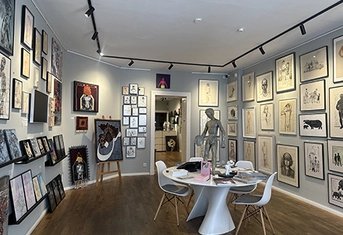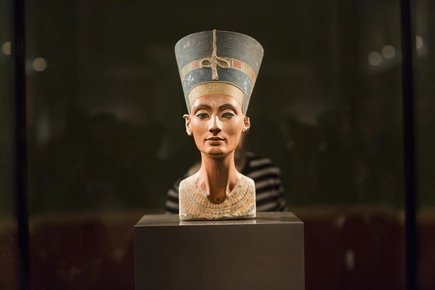
Galleries & Exhibition Spaces in Berlin
Discover contemporary art
WBerlin is one of the cities with the most exhibitions worldwide. At countless vernissages, in project spaces, in galleries, in salons, private flats and at art projects in public spaces, you can also discover a lot in Berlin away from the big venues and events.
Galleries and art exhibitions
Berlin's gallery scene is as diverse as the city itself. Here you can discover contemporary art in large established art museums such as the Neue Nationalgalerie, the Hamburger Bahnhof or the KW Institute for Contemporary Art.
In addition, there are hundreds of art exhibitions in private and municipal galleries, project spaces and exhibition rooms, a small selection of which we present to you here.
We invite you to take a stroll through Berlin's art scene. The spectrum ranges from internationally renowned artists to exciting experimental art and street art. Because Berlin, art and creativity simply belong together.
Highlights of the Berlin art year
Galleries in Mitte: from Auguststraße to the Boros Bunker
Art and subculture in Berlin Mitte
Photography and contemporary art in City West
Architecture and art in Prenzlauer Berg
Contemporary art & discourse in Schöneberg
Street art & in-scene in Friedrichshain and Kreuzberg
Unusual cultural venues in Wedding
Excursion destinations: Art exhibitions in the countryside
1. Berlin Art Week & Gallery Weekend - highlights of the Berlin art year
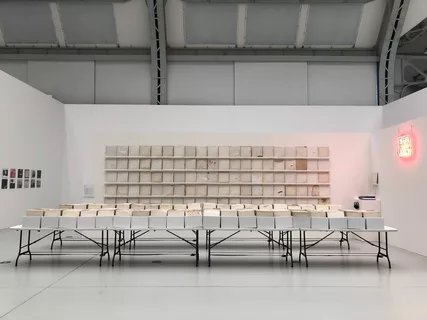
The Berlin Art Week with the Positions art fair and the Gallery Weekend are definitely among the highlights of the year. Every two years, the European Month of Photography (EMOP) attracts an international audience to the city.
In addition, new ideas and projects constantly enrich the scene with pop-up events and exciting shows that you can discover in all corners of the city throughout the year. In many districts, artists open their studios to the public every year. Both the University of the Arts (UdK) and the Academy of the Arts (AdK) invite you to take a look inside their studios and ateliers on their open days.
Contemporary art in Berlin can also be found in rather unusual places: from parlours in private flats to record shops, bars and restaurants - Berlin's art scene is creative. Clubs such as the Kraftwerk, Tresor and Berghain open their rooms for exhibitions and events from time to time.

Experience art in former department stores such as CANK in Neukölln or with Artverse.Underground (until 24 August 2025) in an underground car park on Kudamm. Factory halls also serve as spectacular backdrops for art in Berlin, such as the Kunsthalle in the hangars at the former Tempelhof Airport or the Wilhelm Hallen in Reinickendorf.
2. Gallery districts in Berlin
The most important gallery districts in Berlin can be found in Auguststraße in Mitte, City West and Wedding. But there is also plenty to discover in Friedrichshain-Kreuzberg and Neukölln. You can benefit from attractive discounts at some institutions with the Berlin Welcome Card.
By the way: the whole of Berlin is a gigantic open-air gallery. From sculptures in public spaces to urban art - why not combine your gallery tour with a walk?
2.1. galleries in Mitte: from Auguststraße to the Boros Bunker
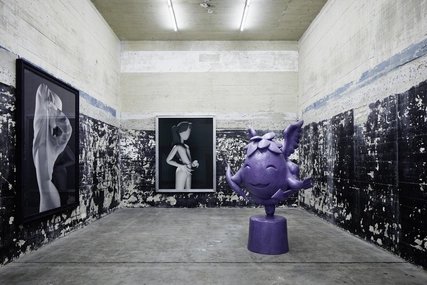
You will find numerous galleries along Auguststraße in Berlin Mitte. Start at KW Insitute for Contemporary Art and stroll along Auguststraße to the EIGEN+Art gallery, for example. A detour to the parallel Linienstraße is also worthwhile, for example to the ifa Gallery, which looks at art across mental and territorial boundaries, to Martin Mertens or to the Neu Gallery in a former thermal power station.
Since 1994, the neugerriemeschneider gallery has been presenting exciting artists beyond Berlin's borders, such as Olafur Eliasson, who was still unknown at the time. Today, Ai Weiwei and Billy Childish are also part of the programme of the internationally active gallery with two locations at Linienstraße 155 and Christinenstraße 18-19/Haus 9 in Berlin, as well as branches in Miami, Basel and Hong Kong.
a 15-minute walk away, the private collector Christian Boros shows his collection in a converted bunker as part of 1.5-hour guided tours. These must be booked in advance.

On an international level, the Julia Stoscheck Foundation focusses on video and digital art as well as new media. In the Schinkel Pavilion, beautifully situated in the park of the Kronprinzenpalais, you will also find installations and sometimes quite provocative media art.
From here you also have a wonderful panoramic view of important Berlin sights such as the Berlin Cathedral, the television tower and the Friedrichswerder Church, now also an exhibition space.
It is also worth making a detour to the collection of the Neuer Berliner Kunstverein (n.b.k.), which was founded in 1969, to the Galerie Thomas Schulte, one of the first galleries to be founded after reunification, to Sprüth Magers and to the Czech Centre with its adjoining gallery.

The Academy of Arts , with branches on Pariser Platz near the Brandenburg Gate and in Hansastrasse, is one of the oldest European cultural institutes with an international community of artists. If you would like to find out what moves the capital's up-and-coming artists, you can talk to them directly on a tour of the University of the Arts (in Charlottenburg). Every summer, many studios are opened for the Open Day.
The art exhibition in the German Bundestag is still an insider tip - even though the foundation stone for the extensive collection was laid back in 1969.
2.2. art and subculture in Berlin Mitte
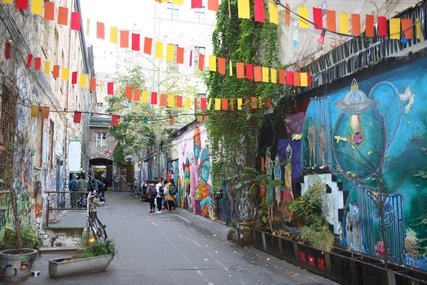
A visit to the Neurotitan Gallery in Haus Schwarzenberg is a bit like travelling back to the wild Berlin of the 1990s. Organised as a non-profit association, the spirit of the creative awakening of the post-reunification era in Berlin lives on here right next to Hackesche Höfe.
In addition to art and subculture , workshops and interventions are organised here to give impetus to the city. In the same building complex you will also find the Monsterkabinett, the Zentral cinema and the Eschschloraque Rümschrümp club bar.
3. Photography and contemporary art in City West
Attentionphotography fans: Not far from the Zoological Garden, the c/o Berlin and the Helmut Newton Foundation are two renowned museums for photography enthusiasts in the immediate vicinity. A trip to Camera Work on Kantstraße is also worthwhile. In the streets around Savignyplatz you will find a whole range of private galleries, such as the CFA Gallery in Grolmannstraße.

If you are interested in Berlin artists, you should visit the Kommunale Galerie Berlin at Hohenzollerndamm 176. In addition to changing exhibitions, the gallery's Artothek lends out 1400 modern and contemporary works of art on a temporary basis, mostly by Berlin artists: Paintings, photography, prints, objects and sculptures - and art for children. One focus is on urban photography. And digital art can be marvelled at at DAM Projects near the Lietzensee.
4. Architecture and art in Prenzlauer Berg
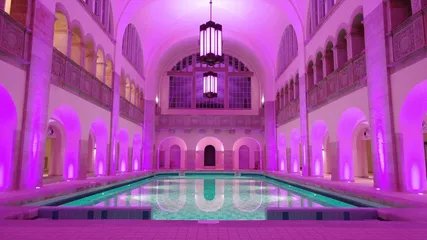
Stadtbad Oderberger
Starting from Pfefferberg, you can explore the gallery scene in Prenzlauer Berg. The Aedes Architecture Forum in Pfefferberg, for example, has been focussing on architecture and urban design since 1980, albeit in different premises at the time.
As Prenzlauer Berg remained largely undamaged during the Second World War, you will find many architecturally exciting buildings here, especially from the Wilhelminian era. 300 buildings are listed as historical monuments, such as the Oderberger Straße municipal swimming pool.
5. Contemporary art & discourse in Schöneberg
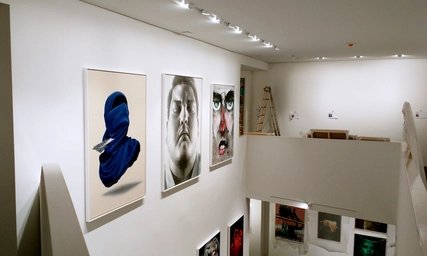
Along Potsdamer Straße and Lützowstraße, not far from Potsdamer Platz and Gleisdreieckpark, you will find numerous galleries, such as Esther Schipper . Here you won't find a static exhibition space, but a lively discourse on contemporary art including lectures, workshops, concerts and performances. A little further south, not far from the Haus am Kleistpark, is the ChertLüdde gallery on Hauptstraße in Schöneberg.
If you are interested in street art, we recommend a trip to Bülowstraße. Here you can stroll past numerous murals to the Urban Nation Museum of Contemporary Art.
6. Galleries and exhibition spaces in Friedrichshain and Kreuzberg
In Berlin's trendy neighbourhoods, you will find art on the street. Starting with the famous East Side Gallery, you can discover numerous other murals on a tour through Friedrichshain-Kreuzberg. Holzmarkt and Urban Spree are also perfect starting points for exploring the street art scene in Berlin. Here you can immerse yourself in Berlin's young urban art scene and experience exhibitions, concerts and more.
The many exhibition spaces that deal with topics such as diversity and social justice are also exciting in a socio-critical context. The neue Gesellschaft für bildende Kunst (ngbk) at Oranienstraße 25 is one of the most active and largest art associations in Germany - organised on a grassroots democratic basis since 1969.
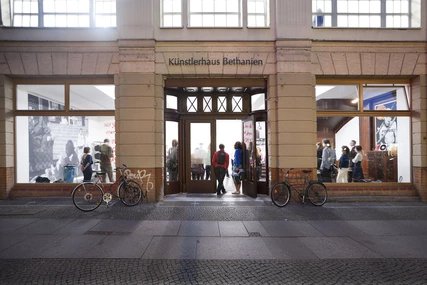
The Kunstraum Kreuzberg/Bethanien is just a seven-minute walk away. Once a deaconess hospital and the centre of Berlin's squatters' scene in the 1960s, the building has a chequered history. Today, the exhibitions in the Kunstraum place contemporary social and cultural processes in the context of contemporary art. Flutgraben e.V., a non-profit art association with many studios, exhibition and project spaces, is located on the border with Treptow.
Kreuzberg is also home to established galleries such as the BBA Gallery, which is run by a team of artists and regularly organises artist prizes. The private König Gallery, which represents around 40 international artists, is housed in a former church.
7. Contemporary art in Neukölln

Neukölln may not (yet) be one of Berlin's cultural centres, but there are still a number of galleries and interesting projects to discover in this diverse district. The perfect starting point is the KINDL - Centre for Contemporary Art. The 1600 square metres of exhibition space include the former boiler house, which is 120 metres high and often displays spectacular site-specific works.
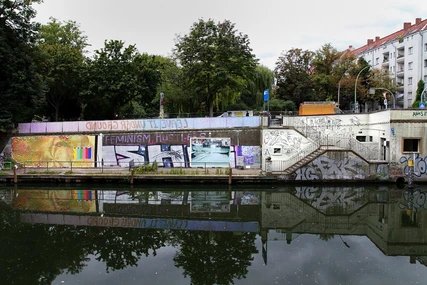
Just a 15-minute walk from here, the Galerie im Körnerpark shows municipal art. Stroll another ten minutes along the lively Karl-Marx-Straße and you will reach the Galerie im Saalbau, also a municipal project.
You can see just how inventive the young, trendy neighbourhood is at the Wildenbruch art bridge. In summer 2021, the historic toilet facility was converted into a quirky exhibition space, reminiscent of times when unusual, non-commercial art and cultural spaces were still a natural part of the cityscape.
8. Unusual cultural venues in Wedding
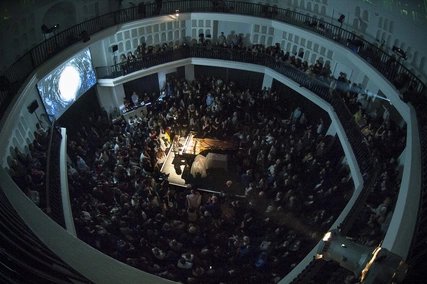
There are now numerous exciting cultural venues in the old working-class neighbourhood. Former factory halls, barracks and other time-honoured buildings provide the perfect backdrop for contemporary art and creative projects. The Silent Green, a former crematorium, now hosts concerts and exhibitions.
The Wiesenburg, a former shelter for the homeless built in 1896, is also home to studios and ateliers in the listed Uferhallen and Uferstudios on the former site of the Berlin transport company. A central cultural venue for the whole of Berlin - and also the starting point for the annual Berlin Art Week.
9. Excursion destinations: Art exhibitions in the countryside
There is also contemporary art to discover outside the centre of Berlin. Located close to the idyllic Grunewald forest, the Haus am Waldsee attracts visitors with its extensive sculpture garden. founded in 1946, the exhibition centre is now a permanent institution with important works by contemporary Berlin artists.
Just a 25-minute walk away, you will find the largest international collection of the Expressionist artists' group at the Brücke Museum. Another 25 minutes further on, you will discover changing exhibitions of young and established contemporary artists at Köppe Contemporary in an art nouveau villa.
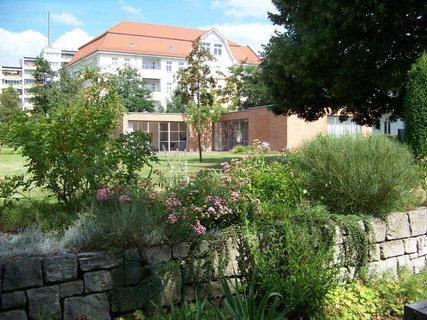
Other exciting excursion destinations for art lovers include Haus Lemke in Pankow, designed by Mies van der Rohe, the Liebermann Villa in the painter's former summer house on Wannsee and the Schwartzsche Villa in Steglitz. In this former summer residence of a Berlin banking family, you will now find a broad cultural programme, as well as a nice café and a large beer garden.
A visit to the Spandau Citadel, one of the most important fortresses of the High Renaissance, also offers a chance to discover contemporary art.
The Haubrok Foundation shows mainly conceptual works in the Fahrbereitschaft in Lichtenberg, a former GDR industrial estate from the 1950s. Nearby, Dark Matter is the world's only museum for light art and interactive installations.
10. Berlin, the capital of sculptures
If you are travelling in Berlin, you will always notice the numerous sculptures in the cityscape: From historical statues to monumental memorials and monuments as well as industrial-cultural and architecturally exciting buildings to modern sculptures and contemporary works of art.
We have a comprehensive overview in Berlin, the capital of sculpture. Other exciting places for those interested are the sculpture garden of the Neue Nationalgalerie, the aforementioned sculpture garden at Haus am Waldsee and the Noack sculpture foundry and gallery at Am Spreebord 9a, directly on the River Spree and not far from Charlottenburg Palace.

Since its foundation in 1897, the Noack foundry has been a central location for sculpture production - a meeting place for art and craftsmanship, tradition and the present. In close collaboration with artists from all over the world, works were created here that today characterise museums, collections and public spaces worldwide.
The Noack family's collection has grown just as steadily as its production. It preserves works by artists who have shaped the house through their art, their trust and their closeness - including Kenneth Armitage, Georg Baselitz, Anna and Ninel Bogouchevskaia, Rainer Fetting, Volkmar Haase, Karl Horst Hödicke, Jone Kvie, Heinz Trökes, Louis Tuallion, Heinz Mack, Vivian Maier, Daniel Mitlanski, Thomas Zipp and the sculpture icons Henry Moore and Michelangelo.
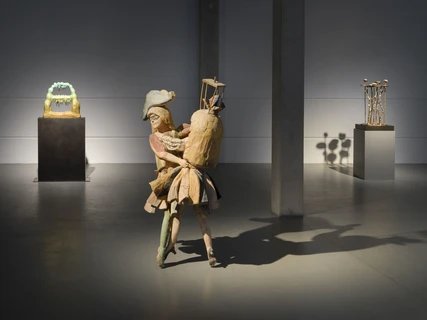
Since its foundation in 1897, the Noack sculpture foundry has been a central location for sculpture production - the Noack family's collection includes works by Kenneth Armitage, Georg Baselitz, Anna and Ninel Bogouchevskaia, Rainer Fetting, Volkmar Haase, Karl Horst Hödicke, Jone Kvie, Heinz Trökes, Louis Tuallion, Heinz Mack, Vivian Maier, Daniel Mitlanski, Thomas Zipp and the sculpture icons Henry Moore and Michelangelo. The exhibition From the Collection will be showing selected works from over seven decades until 14 November.
Art and democracy in Berlin
And another very special tip: together with Kristina Volke, curator of the Bundestag art collection, and her colleague Julia Pfannschmidt, we invite you to take an art walk around the government buildings in our visitBerlin podcast Berlin Unboxed (in German language). Like in no other city, the transparency of German democracy can be seen in the public and freely accessible works of art around the glass dome of the Reichstag in Berlin. These include works by well-known artists such as Pipilotti Rist, Dani Karavan, Christo, Georg Baselitz, Anselm Kiefer, Gerhard Richter, Joseph Beuys and Jenny Holzer.
Description
Das Video gehört zur Folge „Transparenz der Demokratie“ von dem Podcast Berlin Unboxed, den visitBerlin betreibt. Im Podcast geht es um den Reichstag und die gläserne Kuppel. Außerdem werden öffentliche Kunstwerke im Regierungsviertel vorgestellt, die sich mit dem Thema Demokratie beschäftigen. In dem Video ist ein Standbild von der gläsernen Reichstagskuppel am Abend zu sehen. Die Untertitel des Videos können im YouTube Player unter Einstellungen an- und ausgeschaltet werden. Für eine Transkription sollte das Video direkt auf YouTube angeschaut werden.
FAQ
Where can I see art for free in Berlin?
In addition to art in public spaces, which you can discover not only in the government district but all over the city, there are free museums and numerous galleries and art spaces in Berlin that do not charge admission.
Which exhibitions in Berlin should I not miss?
We have summarised the highlights of Berlin's exhibitions for you in the Current Top Exhibitions.
